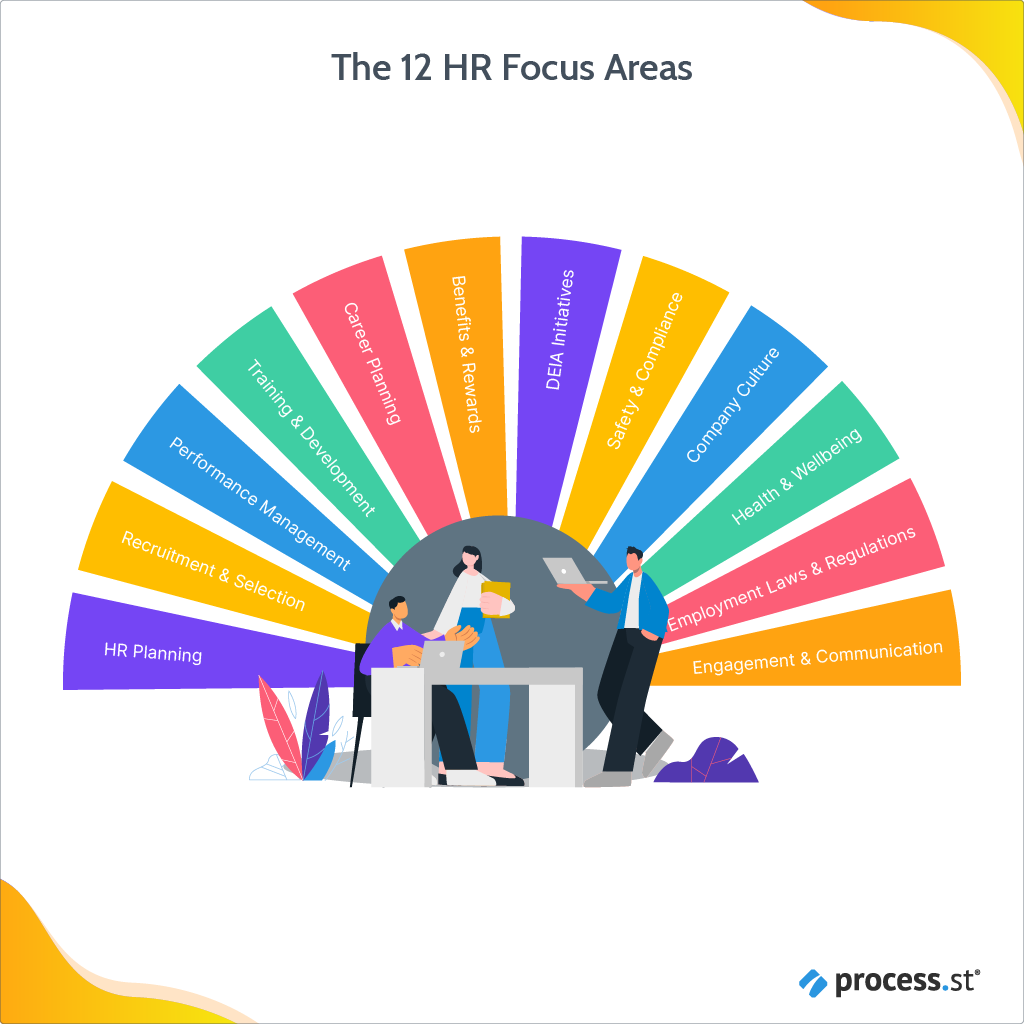 The larger an organization gets, the more complex it is. More people pulling in different directions creates bottlenecks and slows down an organization’s productivity.
The larger an organization gets, the more complex it is. More people pulling in different directions creates bottlenecks and slows down an organization’s productivity.
Ideally, human resource departments should be the ones that keep everyone working toward the same goals. Unfortunately, for many companies, HR isn’t working.
According to McKinsey’s 2012 State of Human Capital Report:
- 42% of HR professionals are not taking action against priority areas;
- 65% of HR professionals are not pursuing innovative approaches;
- and 68% don’t have confidence in their strategy.
That’s why, in this Process Street article, we’re going to take this problem seriously and look at:
- What is human resource management?
- The 12 primary focus areas for human resource management
- Automation & data-driven HR
- Modern process management for modern human resources
What is human resource management?
HR management – or human resources management – is the strategic approach to managing the people in your organization to make it run to the highest possible standards.
Effective HR management should help an organization gain a competitive advantage. This advantage is gained by recognizing the importance of the human capital of the organization and finding ways to make people more efficient and effective.
Not every company has the same approach, though. Companies like Zappos and Buffer prioritize employee autonomy, happiness, and entrepreneurial spirit. Meanwhile, Amazon and Foxconn prefer a more aggressive HR department with an adversarial stance towards industrial relations.
While companies do have a tendency to employ situational leadership theories like Amazon, this article is more focused on the Zappos end of the spectrum.
The 12 primary focus areas for human resource management
Human resource departments perform a myriad of functions depending on company size, industry, strategy, and structure. It’s literally impossible to cover every area that every HR department handles.
That said, there are 12 primary areas that most HR departments will have responsibility for:
- HR Planning
- Recruitment & Selection
- Performance Management
- Training & Development
- Career Planning
- Benefits & Rewards
- DEIA Initiatives
- Safety & Compliance
- Company Culture
- Health & Wellbeing
- Employment Laws & Regulations
- Engagement & Communication
 Some of these are more recent additions to the essential considerations category, but they’re all important things to get right if you want your human resource department to run well.
Some of these are more recent additions to the essential considerations category, but they’re all important things to get right if you want your human resource department to run well.
If we take a look at the 2012 State of Human Capital Report from McKinsey, we can see what the priorities are of the leaders in the field.
Top execs were asked about what their current priorities were and what their priorities will be over the next few years. The answers didn’t really change – it pretty much reads like this:
- Leadership development & succession management
- Talent acquisition and retention
- Strategic workforce planning
- Employee engagement
- Organizational design
McKinsey’s takeaway points from the report were:
- Anticipate and plan for the human capital of tomorrow.
- Secure a steady pipeline for skilled workers – and tomorrow’s leaders.
- Develop strategies to reenergize your employees’ attitudes towards what they do and what you stand for.
- Ensure that human capital becomes more agile.
We can easily see how both the takeaways and priorities connect. To look deeper into the exact relationships between them, let’s divide them into two main categories:
- Hiring
- Organizing
Enhanced hiring practices based on people analytics
In a further McKinsey article from Henri de Romrée, Bruce Fecheyr-Lippens, and Bill Schaninger, “People analytics reveals three things HR may be getting wrong” (2016), three points are highlighted in relation to hiring, retaining, and developing staff:
- Choose the best place to recruit your ideal candidates.
- Cut through noise and bias in your hiring process.
- Improve management to reduce attrition.
Let’s break those down even further.
Choose the best place to recruit your ideal candidates
The best candidates must obviously come from the best schools, or those schools wouldn’t be the best, right?
Not necessarily.
In the example provided by Romrée, et al, an (unnamed) Asian bank relied exclusively on targeting the most prestigious universities for its recruitment strategy. It seemed to work so the plan never changed.
During a major organizational change, however, a lot of processes were tested for efficiency and effectiveness – including their recruitment process.
This is where data analytics comes in. 30 data points over 5 categories were collected for every employee. These points were then analyzed to identify the commonalities between both high and low-performing employees.
With these key indicators mapped out, the bank was able to create profiles of potential employees most likely to succeed in particular positions. 
As it turned out, the bank’s highest performers came from a wide variety of institutions. In fact, the most consistent factor among top performers was the positions they’d held previously.
This indicated that performance was more closely tied to experience than academic achievement and the best way to recruit the best talent was by identifying candidates within specific, entry-level positions that laid the foundation for high performance in future positions.
As a direct result of this restructuring:
- Branch productivity increased by 26%;
- The conversion rate of new recruits increase by 80%;
- Net income during that period increased by 14%.
Traditional recruitment methods don’t work in the contemporary job market. Job seekers have more options and more flexibility than ever before. Consequently, you need to identify which channels your top talent is likely to frequent.
Engage with potential candidates on Twitter and other social media platforms. Be willing to think outside the box. Your next high flyer may have never worked in your industry before but have the experience, perspective, and (increasingly transferable) skills your company needs in order to maintain a competitive advantage.
Cut through noise and bias in your hiring process
Unconscious bias is pervasive. We all have it and – by its nature – none of us are aware of it until after it happens.
Sometimes unconscious bias is useful. It helps us quickly evaluate situations based on previous experience to determine the best course of action in that moment.
It also means our judgment is very rarely (if ever) objective. At the most obvious end of the spectrum, we tend to gravitate towards others who share similarities with us. This might be a similar appearance, similar values, shared hobbies or interests, or even just coming from the same town.
We like people who are like us.
These days, most people are aware of that – or at least aware that they should be aware of it. Unconscious bias is extremely nuanced, though. You may be biased toward someone because they look like your best friend from high school. Maybe they remind you of that awful roommate you had in college, or they’re wearing the type of sweater your dad loves.
How many times have you disliked someone immediately but not known why? What about those times when you’ve “just clicked” with another person?
While those moments may seem to be unexplainable moments of intuition, it’s much more likely that they’re the result of unconscious bias coming into play – unconsciously.
Removing the human from the equation and focusing solely on a candidate’s data and performance metrics, those biased nuances are less likely to come into play. Not only that, but by implementing an automated screening algorithm, you also free up your recruitment team to fully engage with your best prospects.
Improve management to reduce attrition
Money isn’t everything.
In fact, for Millennials and Gen Z, money is the least important factor in choosing where they work. Contemporary job seekers prioritize companies that value transparency and communication, are committed to social issues, and offer their employees opportunities to continuously develop their skills and abilities.
Most importantly, the modern job seeker wants to feel supported, appreciated, and recognized by management. They want to feel their work is meaningful and valued.
Just to drive that point home with a little data:
- 79% of people would quit due to bad leadership.
- 77% would quit for not being promoted.
- 82% would leave due to a lack of progression.
- 43% would return if their boss was replaced.
Ineffective leadership leads to ineffective employees who become disengaged, unmotivated, and unproductive.
Using people analytics to monitor employee performance will identify good candidates for recognition while also highlighting those who could use additional coaching and development.
Access to this type of data makes it easier for leadership to gain perspective on employees on the ground level while also providing line managers with the evidence to support recognition and advancement decisions for their teams.
These metrics can be used to identify management’s strengths and weaknesses, as well. If the same team is less productive while working with a particular manager, it could be an indication that that manager needs additional leadership training – or may even not be suited for the position at all.
When your managers have all the resources they need to be strong, appreciative leaders, they’ll have motivated, engaged teams who are more likely to stick around.
Effective HR management with agile processes
When it comes to organizing, we already know that the McKinsey State of Capital report refers to two key things: preparation for tomorrow and being more agile.
It makes sense: Greater agile practices leave you more adaptable to – and better prepared for – whatever is thrown at you.
According to Martin Reeves, coauthor of Your Strategy Needs a Strategy, we can break down a series of approaches to flexibility which you can use to achieve best practice in each of the above areas of HR:
- The ability to read and act on signals: You need to act fast and knowing what signals should prompt change or action is vital.
- The ability to experiment: You’ll rarely get things right the first time. Testing and tweaking through experimentation will give you much more robust systems in the long run.
- The ability to manage complex multi-company systems: You need to think beyond working in your bubble and start building valuable connections with both customers and suppliers. You can all help each other.
- The ability to mobilize: Utilize organizational structure to help react to changes quickly and shift the focus of your teams in a flash.
Agile business process management is a great route for companies that need to make sure they’re operating in adherence with their procedures, while also wanting to be able to inject agile practices into their daily work.
Automation & data-driven human resource management
We already know from the examples provided above how important it is to leverage digital tools and methods when creating a high-performing HR department.
But what exactly does that entail and how do we go about achieving it?
If we turn to the Cornell HR Review, we can see a series of benefits that should come from a successful digital transformation of a human resource team. Understanding the desired benefits or end state is an important part of realizing what changes are required to get there.
Benefits of digitizing your human resources
- Creating a workforce for future needs: With the drastically changing digital era, there is a need to adopt new approaches that allow companies to build a workforce that meets their digital needs.
- Increase accuracy in dashboards and analytics data: HR transformation makes sure the business relies on accurate, latest data to make informed decisions.
- Develop better employee experience: A digitized human resource department can develop a personalized, engaging experience that meets the needs of employees.
- Better management of the workforce: In order to be successful, organizations are required to manage their employees better, including part-time, extended, and full-time employees.
- Improve efficiency and agility towards evolving business needs: Adopting digital transformation allows businesses to respond to changes quickly while at the same time ensuring excellent performance and superb customer experience.
These are all achievable goals – if you prioritize the right key areas for improvement. Obviously, every business is unique in its own peculiar way, but just like HR departments, there are some things that will be the same regardless.
Key areas for successful HR digital transformation
- Real-time analytics: The department should strive to get real-time data and information that can be used by management to solve today’s business challenges.
- Intelligent solutions: The department should use digital technologies to create new ways of managing the human resource processes and engaging the workforce to unlock the full potential of smart business.
- Natural language interaction: The department should ensure quick execution of operations by encouraging the continued use of human resource digital processes like chatbots, messenger applications, and voice recognition capabilities.
Or, in simple terms: gather data, use new software, and make communication easier.
Leveraging Computerized Adaptive Testing in Recruitment and Development
In addition to the innovative hiring practices highlighted, integrating Computerized Adaptive Testing into the recruitment and employee development processes can significantly enhance HR management’s effectiveness.
CAT’s dynamic approach to assessment, which adjusts the difficulty of questions based on the test taker’s responses, offers a more personalized evaluation of candidates’ abilities and potential for growth.
By utilizing CAT, HR departments can not only streamline the hiring process but also identify specific training and development needs for new hires and existing employees, ensuring a perfect match between the organization’s requirements and the individual’s skills.
Modern process management for modern human resources
Properly utilizing people analytics is absolutely essential to making informed workforce decisions and creating agile business operations.
Rebuilding your current processes from the ground up to be optimized for data analytics can seem overwhelming and impossible – but it doesn’t have to be.
With a process management tool like Process Street, automating and optimizing your human resource management processes is an intuitive and streamlined experience.
Process Street is the modern process management platform for teams. Every team has recurring processes – stuff like onboarding new hires, setting up the next customer, or making sure that team meeting actually stays on track this time.
As an interactive, no-code platform, Process Street transforms those processes into dynamic workflows easily accessible to your entire department from a central location.
You know what that means?
No more rooting around in the back closet for the process binder no one’s seen since the founder wrote them down on Day One. I mean, that’s pretty much a win all around, isn’t it?
Extra perks like adding Automations and integrations with Zapier, Slack, DocuSign – and plenty more – make your recurring tasks less time-consuming and much more accurate.
The Pages feature is great for storing those important documents like employee handbooks and SOPs, so not only are your processes all in one place, your documentation is, too.
We have loads of pre-made templates (like the onboarding workflow below) that you can use straight out of the box or customize however you want. If you’re feeling a little more adventurous, you can even build your own workflows from the ground up.
Click here to get the New Hire Onboarding Process Template workflow!
How do you approach HR management in your business? What would be your key tips and tricks? Let us know in the comments below!







Adam Henshall
I manage the content for Process Street and dabble in other projects inc language exchange app Idyoma on the side. Living in Sevilla in the south of Spain, my current hobby is learning Spanish! @adam_h_h on Twitter. Subscribe to my email newsletter here on Substack: Trust The Process. Or come join the conversation on Reddit at r/ProcessManagement.